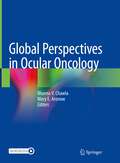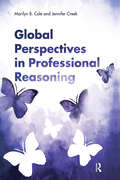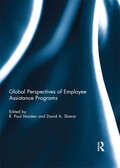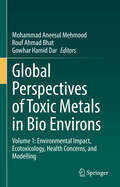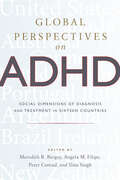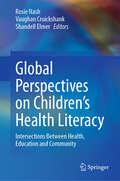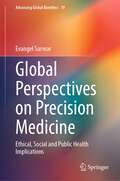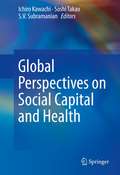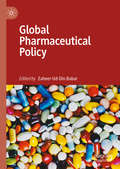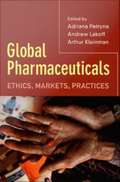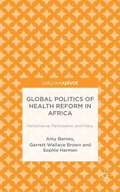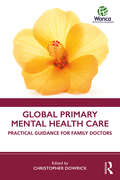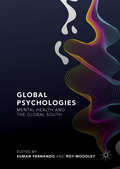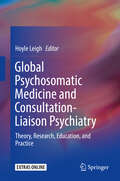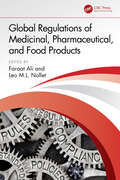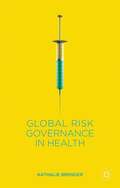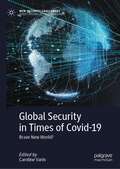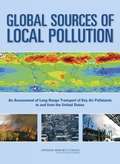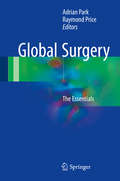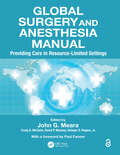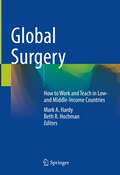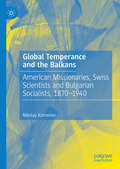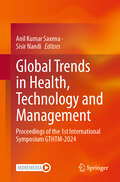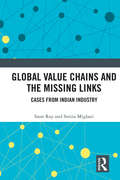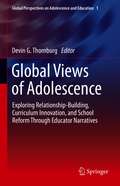- Table View
- List View
Global Perspectives in Ocular Oncology
by Bhavna V. Chawla Mary E. AronowEye cancers vary in presentation depending upon geographic location and access to healthcare. Global Perspectives in Ocular Oncology offers an international platform for leading ocular oncologists and multidisciplinary specialists to highlight worldwide strengths and solutions to the challenges in treating eye cancer. The goal of the book is to provide a universal view on the management of adult and pediatric tumors affecting the eye and ocular adnexa. A range of topics pertinent to the global community have been included. Organized into seven distinct sections, this book covers international collaborations and initiatives, technology and innovations, and novel treatment strategies. In addition, it provides a glimpse into the future of the specialty. The emphasis on sharing perspectives as well as the global and multidisciplinary framework of the book are unique to the market. This work will appeal to a variety of audiences including ocular oncologists and ophthalmic subspecialists, oncologists and other specialists, optometrists, geneticists, allied medical professionals, and trainees entering these disciplines.
Global Perspectives in Professional Reasoning
by Jennifer Creek Marilyn B. ColeGlobal Perspectives in Professional Reasoning is the first text of its kind to address the broader scope of occupational therapy practice and the different types of professional reasoning that can be employed, including strategic, political, nonlinear, creative, and social reasoning. This text encompasses a wide range of thinking skills and cognitive processes used by occupational therapists, from reflecting on practice to solving problems, and from reasoning in the clinic to reasoning in the wider political, social, and cultural worlds.Marilyn B. Cole and Jennifer Creek and their contributors are therapists, educators, and scholars who have explored new areas of professional practice and written about the thought processes that reinforced their actions. The authors come from around the world, providing a global perspective while also demonstrating that occupational therapists within different cultures serve remarkably similar human needs: to be included in their communities, to have occupational choices, and to determine their own life course.Many of the contributors in Global Perspectives in Professional Reasoning have identified and analyzed their own thought processes as they tackled complex and challenging tasks, often in unfamiliar contexts. These challenging tasks have produced several entirely original conceptualizations of professional reasoning, such as development and spiritual reasoning. The contributors start by observing what is going on, try to make sense of the situation, and then work out what to do. Other contributors are fascinated by a theory, a policy, or an approach; study it; and then look for ways to utilize it in practice. Most of the time, contributors focus their attention on the process of reasoning rather than on the specific types of reasoning they are employing or on desired outcomes.Inside Global Perspectives in Professional Reasoning, each chapter charts the learning process that contributors went through as they extended their thinking skills and processes to meet the challenges they encountered. All the chapters describe reasoning in practice and all of them utilize theory. A broad and fresh take on professional reasoning in occupational therapy practice, Global Perspectives in Professional Reasoning is the perfect resource for occupational therapy students and clinicians who want to utilize reasoning to tackle the most complex and challenging of tasks.
Global Perspectives of Employee Assistance Programs
by R. Paul Maiden and David A. ShararGlobal Perspectives of Employee Assistance Programs is the first book of its kind to empirically address the Employee Assistance Program (EAP) concept and model in a diverse, global context. This book features a variety of studies which deal with the design, delivery, cultural adaptability, evaluation, and measurement of international employee assistance programs in a truly global variety of settings. Contributors also evaluate the impact of EAP on expatriates, the potential for an international well-being assessment tool, and the training of international EAP professionals. This book was originally published as a special issue of the Journal of Workplace Behavioral Health.
Global Perspectives of Toxic Metals in Bio Environs: Volume 1: Environmental Impact, Ecotoxicology, Health Concerns, and Modelling
by Rouf Ahmad Bhat Mohammad Aneesul Mehmood Gowhar Hamid DarThis book explores recent advances in heavy metal contamination research in a global context, and focusses on the role of recent technologies like recombinant bioremediation, phytoremediation, DNA technology and nanotechnology to provide sustainable managing strategies to mitigate adverse environmental and health impacts. Many heavy metals are used in industrial and commercial sectors, including iron, zinc, tin, lead, copper, tungsten, cadmium, arsenic, chromium, thallium, and lead, which, when disposed in the natural environment, lead to serious threats to ecological balance in biotic systems and threaten vulnerable human populations. Currently, global scientific communities are very worried about the detrimental health effects of these heavy metals and their adverse effects on almost all biological systems. Scientific research has recorded some alarming adverse impacts of heavy metals on biota like carcinogenesis, mutagenesis, teratogenesis, allergic interactions, endocrine-disruption, bone marrow damage, osteoporosis. and immune system damage. This book is therefore timely, and will be of interest to researchers, students professors, and policymakers examining toxic heavy metals in the environment and their adverse health impacts.
Global Perspectives on ADHD: Social Dimensions of Diagnosis and Treatment in Sixteen Countries
by Edited by Meredith R. Bergey, Angela M. Filipe, Peter Conrad, and Ilina SinghExamining ADHD and its social and medical treatments around the world.Attention deficithyperactivity disorder (ADHD) has been a common psychiatric diagnosis in both children and adults since the 1980s and 1990s in the United States. But the diagnosis was much less common—even unknown—in other parts of the world. By the end of the twentieth century, this was no longer the case, and ADHD diagnosis and treatment became an increasingly widespread global phenomenon. As the diagnosis was adopted around the world, the definition and treatment of ADHD often changed in the context of different psychiatric professions, medical systems, and cultures. Global Perspectives on ADHD is the first book to examine how this expanding public health concern is diagnosed and treated in 16 different countries. In some countries, readers learn, over 10% of school-aged children and adolescents are diagnosed with ADHD; in others, that figure is less than 1%. Some countries focus on medicating children with ADHD; others emphasize parent intervention or child therapy. Showing how a medical diagnosis varies across contexts and time periods, this book explains how those distinctions shape medical interventions and guidelines, filling a much-needed gap by examining ADHD on an international scale. Contributors: Madeleine Akrich, Mari J. Armstrong-Hough, Meredith R. Bergey, Eugenia Bianchi, Christian Bröer, Peter Conrad, Claire Edwards, Silvia A. Faraone, Angela M. Filipe, Alessandra Frigerio, Valéria Portugal Gonçalves, Linda J. Graham, Hiroyuki Ito, Fabian Karsch, Victor Kraak, Claudia Malacrida, Lorenzo Montali, Yasuo Murayama, Sebastián Rojas Navarro, Órla O'Donovan, Francisco Ortega, Mónica Peña Ochoa, Brenton J. Prosser, Vololona Rabeharisoa, Patricio Rojas, Tiffani Semach, Ilina Singh, Rachel Spronk, Junko Teruyama, Masatsugu Tsujii, Fan-Tzu Tseng, Manuel Vallée, Rafaela Zorzanelli
Global Perspectives on Children's Health Literacy: Intersections Between Health, Education and Community
by Rosie Nash Vaughan Cruickshank Shandell ElmerThis book examines global perspectives of health literacy development to explore the intersections between health, education, and community settings. International health literacy experts provide a collection of important insights and recommendations that are urgently required to inform practice and policy. The impetus for this book is a growing recognition that a siloed approach to supporting health and health literacy exists in many countries. This book addresses a gap in the international literature by presenting solutions that promote ongoing collaboration across settings to redress inequity and optimize global health. Identifying intersections between the settings is critically important to supporting these collaborations. Health literacy is the ability to find, use, evaluate and apply information to look after our health. Developing the personal asset of health literacy earlier in life influences adult health behaviours. A Health in All Policies approach has been globally endorsed; however, a health literacy in all settings approach is yet to be realised. As a social determinant of health, health literacy can determine health outcomes, educational attainment, social equity, and productivity. The authors investigate the health literacy development of children and their communities within particular regions, exploring whether health literacy is addressed as a health, education or community issue. They describe where silos exist between and within settings, aiming to highlight areas where health literacy is present. This helps identify challenges and opportunities for optimizing health literacy development. Global Perspectives on Children's Health Literacy is essential reading for public health and health promotion researchers and practitioners, primordial prevention researchers, policy makers, health and education ministers, community service ministers, youth organisations, librarians, school teachers, health and physical education teachers, school nurses, child and parenting services nurses, paediatricians, and allied health professionals who work with children and families (e.g., social workers, speech pathologists, dietitians).
Global Perspectives on Precision Medicine: Ethical, Social and Public Health Implications (Advancing Global Bioethics #19)
by Evangel SarwarThis book presents the promises of Precision Medicine (PM) and the challenges of its implementation in daily clinical routine, while addressing the anticipated ethical and social implications. It is the first book that critically analyzes the potential and the dilemmas relevant to genomics and precision medicine from healthcare, public health and global perspectives. The nine chapters presented in this book elaborate on pharmacogenomics' crucial role in maximizing the potential benefits and minimizing medication's potential risks in groups of people, especially in cancer treatment and other health conditions. Infectious and non-communicable diseases (NCDs) are also discussed in this book by identifying challenges and ways to overcome them. Essential concepts are addressed, such as health-related benefits and harm to individuals and the broader community, including threats to individual privacy and autonomy, which warrant just distribution of scarce resources. The book also identifies and addresses the lack of competency in the healthcare workforce in the era of PM and discusses the path to laying the ethical foundation for the implementation of PM in healthcare organizations.
Global Perspectives on Social Capital and Health
by Ichiro Kawachi S. V. Subramanian Soshi TakaoThis book is a follow up to Social Capital and Health (2008), edited by Kawachi, Subramanian & Kim. Global Perspectives on Social Capital and Health provides a timely update on emerging topics in a fast-growing field, and features contributions from an outstanding international team of scholars, selected from a diverse range of disciplinary backgrounds including: social epidemiology, medical geography, social psychology, social welfare and gerontology, pediatrics, political science, economics, and medical sociology. The book is organized in three parts: Part 1. Emerging directions in social capital research. This section highlights novel directions in social capital research. These include: a) novel settings for conducting research on social capital (workplaces, schools), b) new approaches for causal inference in social capital (instrumental variable analysis, twin fixed effects designs); c) cutting-edge directions for social capital research, including studies of the origins of community social capital, the use of social network analysis to investigate social capital, and novel methods for investigating the link between social capital and crime. Part 2. Social capital and health policy. The three chapters in this section highlight implications of social capital for interventions and health policy. Part 3. Social capital and health in global perspective The four chapters in this section look at research on social capital and health from a global perspective. The authors summarize the empirical studies on social capital and health conducted in each country/region, or each population group; discuss how the concept of social capital "translates" across different cultures; and identify challenges and future directions for research.
Global Pharmaceutical Policy
by Zaheer-Ud-Din BabarMedicines are vital in improving patient health outcomes and pharmaceutical policy is a fundamental component of any health system. However, the global pharmaceutical policy is ever-evolving and data and quality ‘research-based information’ in this field are scarce. This book fills this gap and provides up-to-date empirical information and evidence-based synthesis. It focuses on pertinent key issues in global pharmaceutical policy including medicines safety, generic medicines, pharmaceutical supply chain, medicines financing, access and affordability of medicines, rational use of medicines, pharmacy health services research and access to vaccines and biological products. Featuring policy case studies from varied countries such as Mexico, Russia, China, Kyrgyzstan, and Pakistan, this book comprises a valuable and comprehensive resource for students, funders, policymakers, academics, and researchers interested in this field.
Global Pharmaceuticals: Ethics, Markets, Practices
by Arthur Kleinman Adriana Petryna Andrew LakoffIn some parts of the world spending on pharmaceuticals is astronomical. In others people do not have access to basic or life-saving drugs. Individuals struggle to afford medications; whole populations are neglected, considered too poor to constitute profitable markets for the development and distribution of necessary drugs. The ethnographies brought together in this timely collection analyze both the dynamics of the burgeoning international pharmaceutical trade and the global inequalities that emerge from and are reinforced by market-driven medicine. They demonstrate that questions about who will be treated and who will not filter through every phase of pharmaceutical production, from preclinical research to human testing, marketing, distribution, prescription, and consumption. Whether considering how American drug companies seek to create a market for antidepressants in Japan, how Brazil has created a model HIV/AIDS prevention and treatment program, or how the urban poor in Delhi understand and access healthcare, these essays illuminate the roles of corporations, governments, NGOs, and individuals in relation to global pharmaceuticals. Some essays show how individual and communal identities are affected by the marketing and availability of medications. Among these are an exploration of how the pharmaceutical industry shapes popular and expert understandings of mental illness in North America and Great Britain. There is also an examination of the agonizing choices facing Ugandan families trying to finance AIDS treatment. Several essays explore the inner workings of the emerging international pharmaceutical regime. One looks at the expanding quest for clinical research subjects; another at the entwining of science and business interests in the Argentine market for psychotropic medications. By bringing the moral calculations involved in the production and distribution of pharmaceuticals into stark relief, this collection charts urgent new territory for social scientific research. Contributors. Kalman Applbaum, Joo Biehl, Ranendra K. Das, Veena Das, David Healy, Arthur Kleinman, Betty Kyaddondo, Andrew Lakoff, Anne Lovell, Lotte Meinert, Adriana Petryna, Michael A. Whyte, Susan Reynolds Whyte
Global Politics of Health Reform in Africa: Performance, Participation, and Policy
by Sophie Harman Amy Barnes Garrett Wallace BrownDrawing on qualitative research with African actors and global health institutions, the authors explore the politics of how performance funding modalities and participation are used to shape health reform in African countries as well as the role of African actors, global policy elites and international donors within these processes.
Global Primary Mental Health Care: Practical Guidance for Family Doctors (WONCA Family Medicine)
by Christopher DowrickThis book provides up-to-date, practical information for family doctors on how to assess and manage important mental health problems presenting in primary care settings. Patients frequently present with mental health problems in primary care settings around the world, yet family doctors consistently identify gaps in their knowledge, skills and confidence in how best to care for them. Contributors to the book are experts in primary mental health care and have consulted with family doctors around the world, to identify their main learning needs. Each of the nine core chapters will begin with a set of key points on ‘how to do it’ and will end with educational material in the form of clinical scenarios and multiple choice questions. This book describes core competencies for primary mental health care, clarifies how to conduct a first consultation about depression, reviews non-drug interventions for common mental health problems, discusses the management of unexplained physical symptoms, and advises on the physical health care of patients with severe mental illness. It explores the mental health needs of migrants and young people, and explains how to manage problems of frailty, multimorbidity and dementia. This book will be of interest to family doctors and students specialising in family medicine worldwide.
Global Psychologies: Mental Health and the Global South
by Roy Moodley Suman FernandoThis book critiques our reliance on Eurocentric knowledge in the education and training of psychology and psychiatry. Chapters explore the diversity of ‘constructions of the self’ in non-Western cultures, examining traditional psychologies from Africa, Asia, Australasia, and Pre-Columbian America. The authors discuss liberation psychologies and contemporary movements in healing and psychological therapy that draw on both Western and non-Western sources of knowledge. A central theme confronted is the importance, in a rapidly shrinking world, for knowledge systems derived from diverse cultures to be explored and disseminated equally. The authors contend that for this to happen, academia as a whole must lead in promoting cross-national and cross-cultural understanding that is free of colonial misconceptions and prejudices. This unique collection will be of value to all levels of study and practice across psychology and psychiatry and to anyone interested in looking beyond Western definitions and understandings.
Global Psychosomatic Medicine and Consultation-Liaison Psychiatry: Theory, Research, Education, and Practice
by Hoyle LeighThis authoritative reference surveys mind-body healing concepts and psychosomatic medicine in diverse countries and regions of the world. It provides practical insights on the Western division between medical and mental healing and useful information concerning recent efforts to bridge that enduring divide, particularly in the use of ancient and indigenous healing knowledge in psychosomatic practice. Coverage compares and contrasts current applications of psychosomatic medicine and/or consultation-liaison psychiatry as conducted in such representative countries as France, Britain, China, India, Argentina, Canada, and the United States. And the book predicts how this synthesis of traditions and advances will progress as it: Traces the history and development of psychosomatic medicine.Reviews contributions of traditional healing methods to psychosomatic medicine.Analyzes national styles of psychosomatic medicine as practiced in specific countries.Compares the status of psychosomatic medicine / consultation-liaison psychiatry in various countries. Considers the future of psychosomatic medicine as the field, and the world, evolves. Global Psychosomatic Medicine and Consultation-Liaison Psychiatry expands the knowledge base for psychiatrists, primary care physicians, psychiatric and primary care residents, medical students, behavioral medicine specialists, and others who are interested global and regional perspective on providing biopsychosocial care. It is also relevant for advanced students in health psychology and behavioral medicine, and for professionals in related health fields.
Global Regulations of Medicinal, Pharmaceutical, and Food Products
by Leo M.L. Nollet Faraat AliMedicine regulation demands the application of sound medical, scientific, and technical knowledge and skills, and operates within a legal framework. Regulatory functions involve interactions with various stakeholders (e.g., manufacturers, traders, consumers, health professionals, researchers, and governments) whose economic, social, and political motives may differ, making implementation of regulation both politically and technically challenging. This book discusses regulatory landscape globally and the current global regulatory scenario of medicinal products and food products comprehensively.Features: Discusses how recent developments of medicinal and food products have opened up innovative solutions for many of the current challenges societies face presently. Explores the manifold variations between the regulatory bodies in different countries that have not previously been collected to this extent. Presents details on the substantial progress in analytical methodologies for labelling applications and the creation of appropriate test criteria for pharmaceuticals and their safety analysis. Reviews how more worldwide collaboration and cooperation in the regulatory area is still required.
Global Risk Governance In Health
by Nathalie BrenderEpidemics know no borders and are often characterized by a high level of uncertainty, causing major challenges in risk governance. The author shows the emergence of global risk governance processes and the key role that the World Health Organization (WHO) plays within them.
Global Security in Times of Covid-19: Brave New World? (New Security Challenges)
by Caroline VarinWritten in the middle of a pandemic, this book examines the effect of COVID-19 on regional and global security threats in the first 18 months of the crisis. Throughout history, epidemics have disrupted human civilisations, changed the structure of societies, decided the outcome of wars and prompted incredible technological innovation. Despite massive progress in science, institution-building and cooperation over the past 100 years, COVID-19 has revealed the weaknesses of a world under-prepared for a new disease – that had been widely expected and long overdue! This edited volume brings together leading security experts from Africa, Asia, Europe, the Americas and the Middle East to share their analysis of the COVID-19 outbreak and its impact on major security threats, including the rise of terrorists and criminal networks and global power politics. The book highlights important lessons learnt from all corners of the planet, in particular the need for cross-sectional, regional and international cooperation and solidarity when it comes to facing any transnational security threat that does not respect political boundaries.
Global Sources of Local Pollution: An Assessment of Long-Range Transport of Key Air Pollutants to and from the United States
by National Research Council of the National AcademiesRecent advances in air pollution monitoring and modeling capabilities have made it possible to show that air pollution can be transported long distances and that adverse impacts of emitted pollutants cannot be confined to one country or even one continent. Pollutants from traffic, cooking stoves, and factories emitted half a world away can make the air we inhale today more hazardous for our health. The relative importance of this "imported" pollution is likely to increase, as emissions in developing countries grow, and air quality standards in industrial countries are tightened. Global Sources of Local Pollution examines the impact of the long-range transport of four key air pollutants (ozone, particulate matter, mercury, and persistent organic pollutants) on air quality and pollutant deposition in the United States. It also explores the environmental impacts of U.S. emissions on other parts of the world. The book recommends that the United States work with the international community to develop an integrated system for determining pollution sources and impacts and to design effective response strategies. This book will be useful to international, federal, state, and local policy makers responsible for understanding and managing air pollution and its impacts on human health and well-being.
Global Surgery
by Adrian Park Raymond PriceThis text was developed as a book aimed at surgeons and allied health professionals that provides an introduction to the unmet needs , epidemiological, socioeconomic and even political factors that frame Global Surgery. Following upon an understanding of these issues, the text is a practical guide that enables the reader on several levels: to work cross culturally , build relationships and negotiate the logistical challenges of bringing surgical care to low resource settings; to develop an approach to the management of various clinical conditions that would be unfamiliar to most "western" surgeons. Global Surgery is a recently coined term that encompasses many potential meanings. Most would agree that it focuses on the growing recognition of the crisis of access to quality surgical care in low resource settings. Such scenarios exist on every continent. Increasingly surgeons, allied health professionals (NGO), Public Health / Health Policy professionals as well as governmental and non-governmental organizations are engaging in this field. Many surgeons have an interest in Global Health and a desire to become involved but feel ill equipped to do so and unsure where to start. Global Surgery: The Essentials serves as a ready resource to equip surgeons to manage clinical scenarios that lie beyond the scope of their training or current practice but that they would reasonably be expected to encounter in the field.
Global Surgery and Anesthesia Manual: Providing Care in Resource-limited Settings
by John G. Meara Craig D. McClain Selwyn O. Rogers David P. MooneyTo help advance global surgery as a public health intervention, providers and students require a practical, hands-on manual to train them to provide safe and effective surgery and anesthesia in resource-limited settings. This guide provides in-depth instruction on epidemiology and ethics surrounding surgical services, and on anesthesia, non-trauma surgery, and trauma surgery. With contributions from a group of culturally and academically diverse clinicians, each chapter is enriched by at least one commentary from a surgeon or anesthetist in a low- or middle-income country (LMIC) who shares first-hand perspectives on the realities and complexities of providing surgical care in these settings with limited resources.
Global Surgery: How to Work and Teach in Low- and Middle-Income Countries
by Mark A. Hardy Beth R. HochmanFew books have been published to assist local and visiting clinicians in addressing opportunities to expand surgical care in low- and middle-income countries. With contributions from international experts and surgical leaders, this book serves as a valuable resource for local and visiting faculty, trainees, and students in their endeavors to deliver surgical services in existing facilities as well as to develop new infrastructures for specialized surgical care. This book presents an anthology of important lessons gleaned from the experiences of participants in selected academic global surgery centers and existing partnerships all over the world. Contributing authors summarize methods to build partnerships and expand capacity with a focus not only on how to, but also on what worked, what didn’t work, and what could be done differently. They discuss specific examples ranging from implementing colon cancer screening to building a transplant program. In addition, several chapters describe approaches to diagnosis and management of specific surgical pathologies in limited resource environments as a complement to standard surgical texts in general surgery, thoracic surgery, neurosurgery, urology, obstetrics and gynecology, orthopedics, and surgery for contractures and burns. Practical and user-friendly, Global Surgery encapsulates the increasing enthusiasm of young faculty, trainees and medical students to improve access to surgical care in the world’s low- and middle-income countries.
Global Temperance and the Balkans: American Missionaries, Swiss Scientists and Bulgarian Socialists, 1870–1940
by Nikolay KamenovThis book examines the local manifestation of the global temperance movement in the Balkans. It argues that regional histories of social movements in the modern period could not be sufficiently understood in isolation. Moreover, the book argues that broad transformations of social movements – for example, the power centers associated with moral/religious temperance and the later, scientifically based anti-alcohol campaigns – are more easily identifiable through a detailed regional study. For this purpose, the book begins by sketching the historical development as well as the main historiographical themes surrounding the worldwide temperance movement. The book then zooms in on the movement in the Balkans and Bulgaria in particular. American missionaries founded the temperance movement in the closing decades of the nineteenth century. The interwar period, however, witnessed the proliferation of new, professional organizations. The book discusses the various branches as well as their international and political affiliations, showing that the anti-alcohol reform movement was one of the most important social movements in the region.
Global Trends in Health, Technology and Management: Proceedings of the 1st International Symposium GTHTM-2024
by Anil Kumar Saxena Sisir NandiThis book presents the proceedings of the 1st International Symposium on Global Trends in Health, Technology and Management (GTHTM-2024), held on March 15-17, 2024, in Dehradun, India. It reports on recent advances in the interdisciplinary fields of health, technology, and management covering a broad spectrum of topics like drug discovery and development including diseases like cancer, tropical and lifestyle diseases, agroecology, artificial intelligence, and machine learning. The symposium is jointly organised by the Global Health Techno Management Forum and the Global Institute of Pharmaceutical Education and Research, Kashipur, India, together with the Veer Madho Singh Bhandari Uttarakhand Technical University, Dehradun, India. It builds on the success of previous conferences such as the International Symposium on Drug Design and Development Research (DDDR-2021), International Symposium on Current Trends in Pharmaceutical and Medical Sciences (CTPMS-2020), International seminar on Global Trends in Health and Environment (2016), International Seminar on Pharmaceutical Education and Research (ISPER-2010), and the 9th International Symposium on Computational Methods in Toxicology and Pharmacology Integrating Internet Resources (CMTPI-2017). Offering a timely snapshot of cutting-edge, multidisciplinary research and developments in drug design and health sciences, these proceedings facilitate the transfer of these findings to industry and offer a unique perspective on One Health sustainability. As such, the book will appeal not only to students and researchers but also to professionals interested in these fields.
Global Value Chains and the Missing Links: Cases from Indian Industry
by Saon Ray Smita MiglaniGlobal value chains (GVCs) are fraught with the phenomenon of fragmentation and dispersion of production across the world. India presents a unique example with its high potential in manufacturing capability but low integration in GVCs. This book examines the reasons why India has failed to integrate within GVCs so far and looks at key examples to understand the impediments in this process. The chapters bring together case studies from across the manufacturing industry – labour-intensive (garment, paper and diamond), capital-intensive (automobile and petrochemical), and knowledge-intensive (semi-conductor microchip, chemical and pharmaceutical) sectors. Together, they present stories of successful integration of some firms in GVCs as well as the difficulties faced by them. The volume also highlights the importance of GVCs in the context of developing countries in terms of benefits such as income and value generation, knowledge and technology collaborations, and advances in systems and processes. This book will interest scholars and researchers in economics, international trade studies, development economics and business management as well as to practitioners, policymakers, government officials, and those in the corporate sector.
Global Views of Adolescence: Exploring Relationship-Building, Curriculum Innovation, and School Reform Through Educator Narratives (Global Perspectives on Adolescence and Education #1)
by Devin G. ThornburgThis book addresses what teachers and school leaders from a dozen countries see as the social and emotional strengths, interests and needs of adolescents in their schools and communities; how they innovate their programs and practices to respond to their students’ lives. The book also describes how educators themselves benefit from social and emotional supports to be responsive. Rather than assume that there are universal themes in adolescents’ lives, the book is intended to illuminate the local, contextual, and powerful insights of educators daily working with students. In many intentional respects, each serves as an action research study with an effort to better the process and outcomes of their students’ growth and learning as well as to enrich the classroom. The chapters are organized by themes, ranging from challenges adolescents face in that particular locale to curriculum work that is project-based, transdisciplinary, and tied to the communities where the adolescents live. ‘The voices of adolescents, particularly with regard to their social and emotional development have been neglected in the literature. Thus, we know very little about their feelings and personal experiences as they progress through their schooling. A book such as this will be beneficial in terms of providing a contribution to this field, thereby increasing our understanding of the issues faced by adolescents across countries and cultures.’ Peggy L. Anderson, Ph.D., Metropolitan State University of Denver ‘The outstanding strength of this book is quite precisely its international scope: here is an anthology that lives up to the claims made by its title. Anyone interested in either adolescent development or Social and Emotional Learning in real world as opposed to abstract settings will appreciate the breadth of experience described.’ Mokhtar El Maouhal, Laboratoire de Recherche sur les Langues et la Communication
